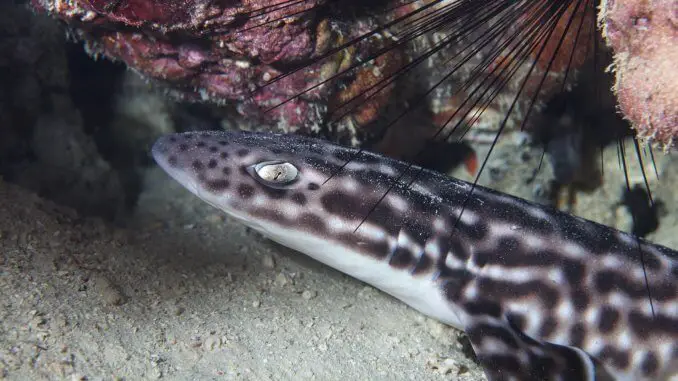
When you think of aquarium fish, sharks are probably the last creature that comes to mind to keep in your tank. However, we are here to introduce to you maybe one of the most unusual pets out there!
Cat Sharks are a diverse group that includes many different species from multiple families. They can be kept in a home aquarium and will be a unique addition to any tank.
They are one of the few species that lets you bring a part of the ocean into your home. If you are that way inclined, some of them can even be kept in reef tanks.
Ever wanted to find out what it’s like to have your own shark? Well, now is a great chance!
Keep reading and we will teach you all you need to know to successfully keep one…
TABLE OF CONTENTS
Cat Sharks Facts & Overview
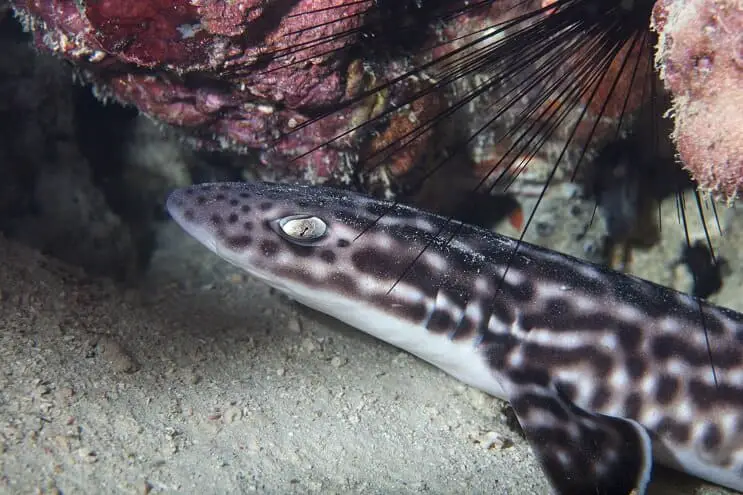
| Category | Rating |
| Care Level: | Experienced |
| Temperament: | Aggressive |
| Color: | Various |
| Lifespan: | Up to 25 years |
| Size: | Up to 60 inches |
| Diet: | Carnivore |
| Family: | Scyliorhinidae, Hemiscylliidae, Pseudotriakidae |
| Minimum Tank Size: | 350 gallons |
| Tank Setup: | Marine; mildly planted/decorated |
| Compatibility: | Limited |
Cat Shark is a name commonly used to describe multiple families (Hemiscylliidae, Scyliorhinidae, Pseudotriakidae) of saltwater sharks that are popular among home aquarists.
- Banded Cat Sharks for example, are a member of the Hemiscylliidae family. While other favorites, like Marbled Cat Sharks are from the Scyliorhinidae family.
- Species from the Scyliorhinidae family can be found all over the world in tropical waters. Some species are endemic, which means they are only found in a specific area.
- Bamboo sharks from the family Hemiscylliidae are found in Indo-Pacific Asia, a geographic region that stretches from India to Australia’s northern coasts and reaches Japan’s southern islands.
False Cat Sharks, on the other hand, are included in the family Pseudotriakidae. They are not usually kept as pets due to their enormous size.
The lifespan of these fish is very dependent on how good their living conditions are. Under well-monitored water parameters, they live up to 20 years.
Buying one can be a bit tricky depending on where you live. In the US they can be purchased online. Finding them in a store is more complicated due to their size.
Price also greatly varies depending on the species you decide to buy. Marble Cat Sharks (one of the most popular choices) are priced at around $80–85 for a half-grown juvenile. Banded Cat Shark can go for about $150–170. Coral Cat Sharks can be found at around $300.
What is unusual about the Cat Shark trade is that you can buy an egg. This will cost you about $45–50 per individual egg. The perks of getting an egg is that you will be able to watch them grow and there is a larger chance that they will successfully adapt to the tank.
Appearance
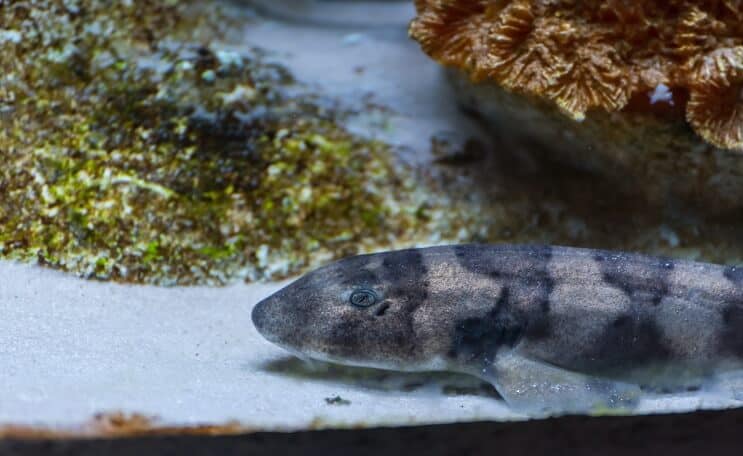
There is a great variety in color and size among Cat Sharks. Most species are dark with some types having different beautiful color patterns.
Many have long cylindrical shaped bodies with a short narrow head with cat-like eyes.
The size of the Shark varies greatly. Some species reach up to 30 inches while others can grow as big as 60 inches.
Banded Cat Shark
Also called the Bamboo Shark (Chiloscyllium punctatum), this member of the Hemiscylliidae family is easily recognized by their distinguishable bands on their skin.
They form a rather interesting color pattern, with a chain of dark and light stripes along the whole body. Their body is a cream pale color, with dark thick stripes which wrap. They can grow up to 42 inches in length.
Coral Cat Shark
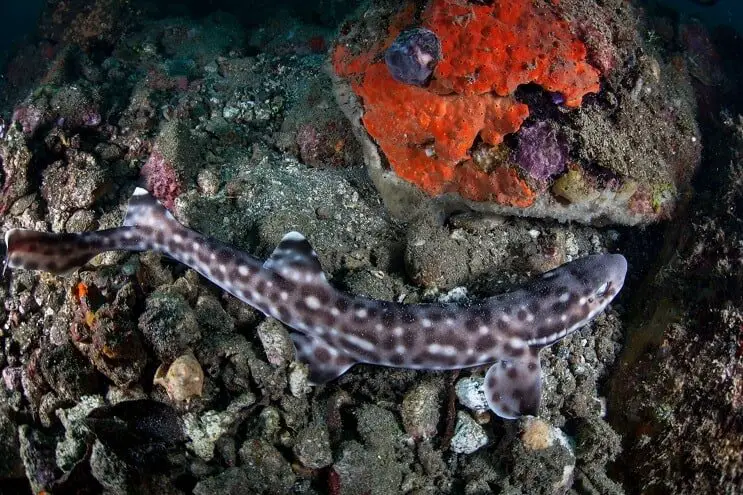
Known also as the Indian Coral Cat Shark (Atelomycterus marmoratus), this fish is a very popular choice among fish keepers. Its coloration looks a little bit chaotic at first sight with a mix of dark and light dots or lines spreading across its body. Their heads can be covered in small densely packed dots or be mono-colored.
They can grow up to 28 inches but on the average reach around 25 inches.
Marbled Cat Shark
More widely known as an Australian Marbled Cat Shark (Atelomycterus macleayi), they are somewhat similar to Coral Cat Sharks in appearance. Their body is covered in white dots on a saturated black background while the rest of it is a brownish color. Dark parts of their coloring sometimes form bands.
The lower part of their head and its sides are usually light grey and their eyes protrude above the head.
They reach up to 24 inches and are usually easy to find, compared to some other species.
False Cat Shark
A member of the Pseudotriakidae family, the False Cat Shark (Pseudotriakis microdon) isn’t very popular with aquarists. They’re also quite plain in color.
They can reach a significant length, growing up to nearly 10 feet. Their size is partially responsible for their low popularity.
Habitat and Tank Conditions
Cat Sharks are marine species who prefer warm waters and spend most of their life scavenging the seabed for food. Because of the diversity in the group, these sharks can be found in a range of different habitats.
For example, Coral Cat Sharks, as the name may suggest, are mostly found near coastal reefs.
The seabed in their habitats consists of sandy gravel or sand. Rocks, boulders and other types of natural shelters are scattered all over the place.
Remember though, there is huge diversity so be sure to research the individual species you want.

Tank Setup
One of the biggest challenges with this fish is the initial setup.
The most important thing to keep in mind is that they are saltwater fish; the salinity must always be maintained. This is done by adding salt or a variety of chemical solutions to your tank.
Saltwater tanks generally require more attention than freshwater ones. But don’t let that scare you away. Once you get the common misunderstandings out of the way, you will find that marine tanks can be even more exciting.
Your tank setup will need to be adjusted depending on which Shark you get.
For the sake of this article we will focus on the Banded Cat Shark; they are one of the most popular with aquarium enthusiasts.
The substrate should be well filtered and not contain any sharp objects that might hurt the shark. Sandy gravel is best.
They will also need some live rocks and hiding spots. You can arrange the rocks in a way to form a crevice. This will help your fish feel more comfortable.
The temperature in the tank should be kept between 75.2–78.8°F. A solid filtration system is also needed. Ideally, currents should be created near the bottom of the tank. Given the size of the fish, you will also need a protein skimmer to remove waste.
Acidity (pH) should be kept in a very narrow range: 8.2–8.4. The specific gravity should be between 1.020-1.025 and the dKH between 8-12.
Lighting shouldn’t be very intense. A low or medium powered lamp, between 300–400W is recommended.
What Size Aquarium Do Cat Sharks Need?
As most breeds of Cat Sharks reach 40-48 inches, you will need at least a 350-gallon tank.
The footprint of the tank is also important because they need as much space as possible to swim. So choose a round or square tank with a large floor space.
Tank Mates
They spend most of their time on the seabed, alongside other bottom dwellers. They are quite aggressive in the tank. Some species are less aggressive than others but in general they are hostile towards their tank mates, even if the fish is larger.
You can however keep them with smaller fish if they don’t cross paths very often.
Keeping small fish with them is still tricky as they might end up being eaten. The same goes for non-fish inhabitants or crustaceans (which is their favorite food).
The more spacious the aquarium is the less aggressive the fish will be. If your tank is big enough, multiple Sharks can be kept together.
Some fish you might consider are stingrays, other Cat Sharks, some Tangs such as Yellow or Hippo Tangs, Groupers (as long as they’re not aggressive) and Harlequin Tusks.
Avoid placing potential competitors in the same tank. By that we mean large, carnivorous fish that will likely cause problems. For example, eels or fish from the Percidae family.
Also avoid adding Triggers, Puffers or Angels as they are all likely to pick on the shark.
Keeping Cat Sharks Together
Although most Cat Sharks are solitary, they can be kept together. Keeping them together from a young age is preferred as they will get used to each other. We recommend that you keep no more than 3 of them together even if your tank is large.
Diet
Cat Sharks are seabed predators. Their natural diet consists of mollusks, crustaceans, invertebrates or small fish. As you can imagine, they will happily gobble anything.
Some species will only feed on fish that they can swallow whole. That’s because their teeth are not adapted to biting through prey, only to crush shells and catch food.
In captivity they should be fed live meaty foods. For example, shrimps, fish fillets, meat pieces, squid fillets, live small fish and similar things. The size of the portion should be adjusted depending on whether it’s an adult or not.
As they can be greedy with food, it’s recommended to feed them big portions 3-4 times a week or small ones 2-3 times a day. Their feeding pattern may drastically change if the water temperature isn’t watched closely.
Care
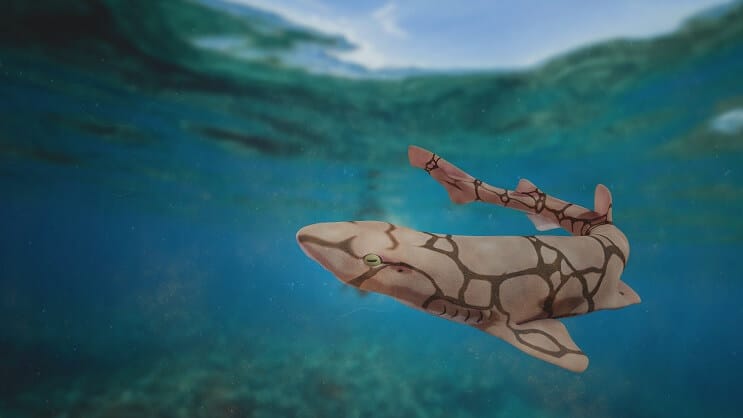
These species are quite hardy but there are still some things you should pay extra attention to.
One of those things is water parameters. They are extremely sensitive to any sudden changes.
The temperature range should be watched closely. Low temperature may cause their metabolism to slow down, whereas in high temperatures they stop feeding and the risk of parasitic infection increases.
Clean water is key to keeping them healthy. Ideally, 10–15% of the water should be renewed weekly. Don’t forget to add marine salt to your aquarium.
We have mentioned the importance of fine substrate previously. This is important as the fish may get hurt and catch an infection as a result. All of that is easily avoided by just keeping the bottom of your tank nice and clean.
Catfish are not susceptible to any one particular disease, although infections are quite common. If they lack iodine, catfish can develop a goiter; a very nasty condition that results in the enlargement of their endocrine gland. As preventive measures add some iodine as a supplement according to the instructions to make sure this doesn’t happen to your pet.
If your fish gets damaged, it should recover naturally under good aquarium conditions. But if this doesn’t happen and your fish gets infected, place it in a quarantine tank and add antibacterial chemicals to water.
Typical Behavior
They are believed to be schooling fish and some are found in groups of 12 but they can be solitary as well. Although not active predators, they are still aggressive towards most other aquarium fish.
Their feeding behavior is very distant from that of typical sharks. In the wild most species are nocturnal predators, which means they will go searching for food during the night.
Bamboo Sharks have barbels, which are like the whiskers of a cat. They use their barbels to probe the seafloor to find potential prey.
Many species are included in the group called ground sharks (Carcharhiniformes). The name speaks for itself. These fish in almost every case are found near the seabed where they swim around searching for food.
As you may have already guessed, in the tank these fish will be found swimming around and searching for food in the bottom section of the tank.
Breeding
Cat Sharks are oviparous, which means that they lay eggs. Due to many different factors, the breeding process presents various difficulties. Sharks are typically bred on specialized farms under strict conditions.
These conditions are extremely hard to replicate at home. Additionally, their size complicates things even further.
Certain species (Coral Cat Sharks) have been successfully bred in home aquariums. With this species, the maturity of the fish can be told by their size. Males reach puberty when they are about 15 inches, whereas females are ready for reproduction when they reach 17 inches.
Females usually attach eggs to substrate or objects on the seabed. Fry are usually around 4 inches long. Right after the fry hatch, they start looking for food.
However, as mentioned earlier don’t expect to breed these fish in a home aquarium.
Is A Cat Shark Suitable For Your Aquarium?
Cat Sharks are beautiful and unusual pets that you rarely see in home aquariums. There is a great variety of species among them, and plenty to choose from.
They are big saltwater fish and as such will require extra care, even though they’re not prone to any particular disease. Because knowledge of the saltwater setup is required and a lot of time is needed, we only recommend them to expert aquarists.
Check out some other interesting saltwater fish that you may start off with if you want to get into the marine fishkeeping hobby.
This amount of work, however, will be worth it. Having a shark in the tank will surely impress any visitor.
If you’re an experienced fish keeper, and have been looking for something new to spice things up, look no further.
Have you ever thought about getting a shark? Let us know in the comments section below…

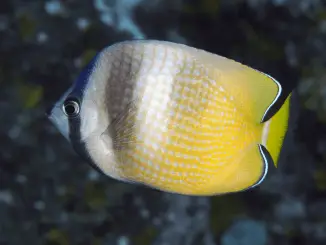

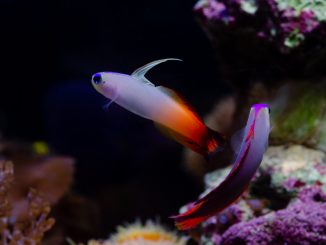
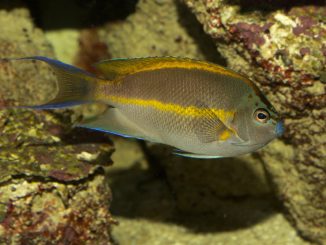
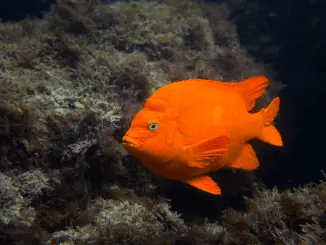
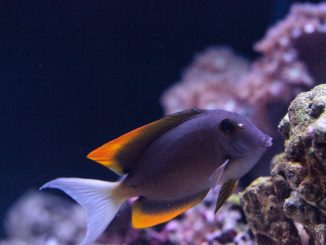
Be the first to comment